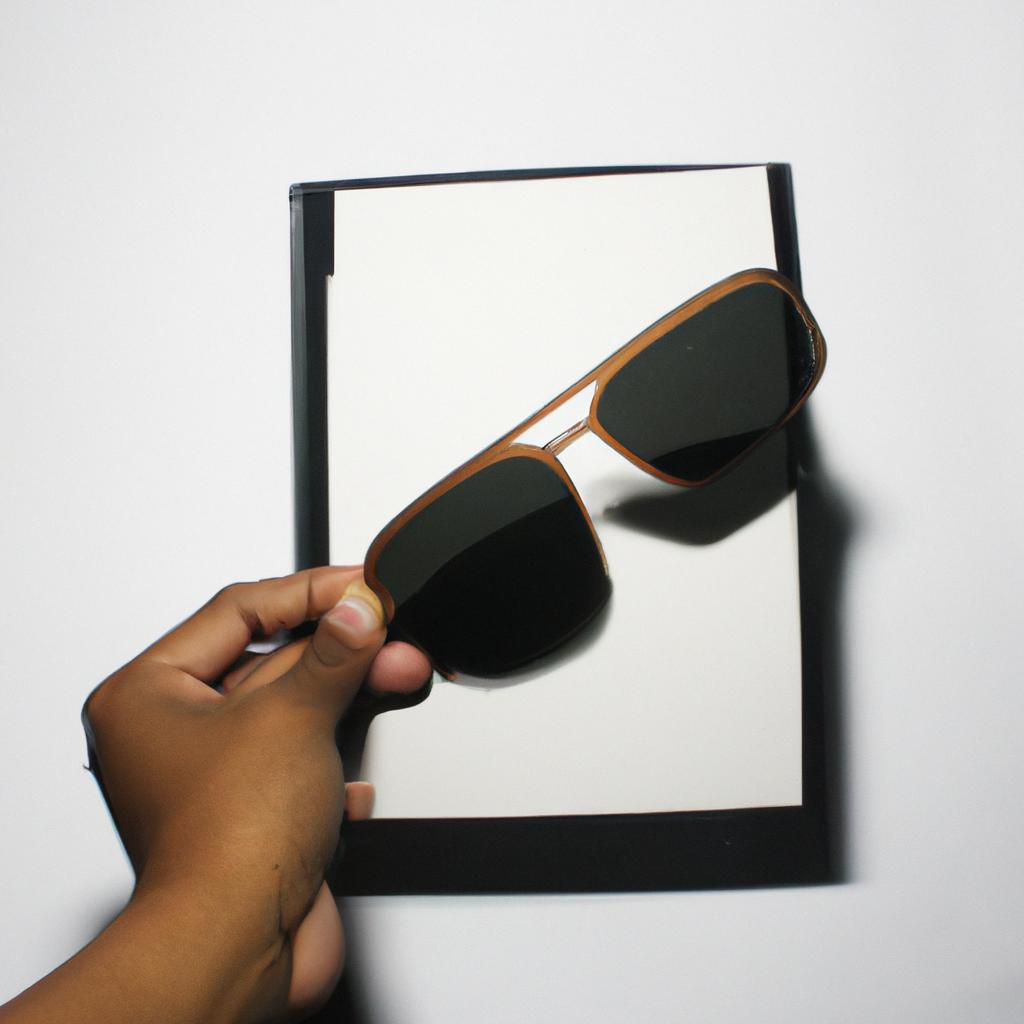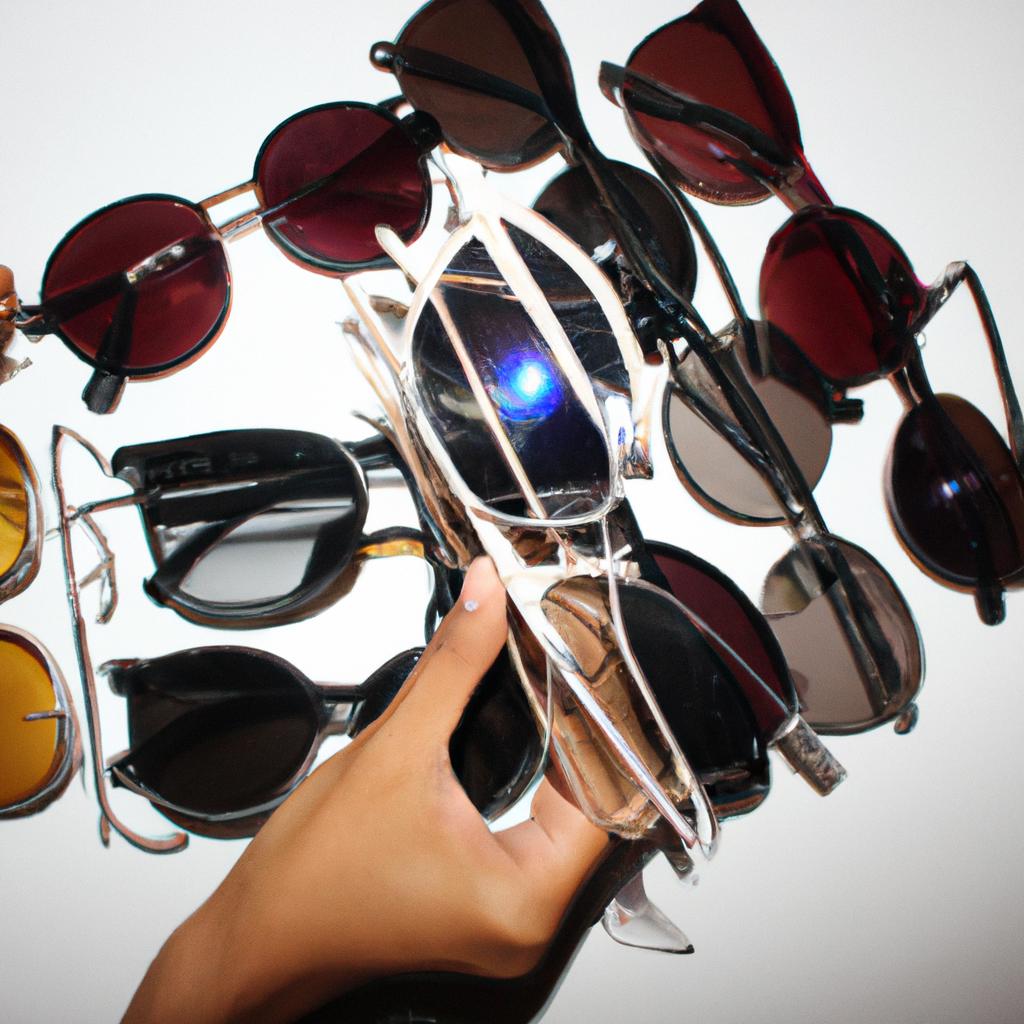Acetate: Sunglasses Frame Materials

Acetate, a widely used material for sunglasses frames, has garnered increasing attention in recent years due to its versatile properties and aesthetic appeal. This article explores the characteristics and benefits of acetate as a frame material in the context of sunglass production. To illustrate its practical application, we will examine a hypothetical case study involving a renowned eyewear brand that successfully capitalized on acetate’s unique features to enhance their product offerings.
In today’s competitive market, where fashion trends evolve rapidly, choosing an appropriate frame material is crucial for eyewear manufacturers seeking to meet consumer demands. Acetate stands out among other options due to its remarkable flexibility, durability, and lightweight nature. These qualities enable designers to create stylish sunglasses with intricate shapes and patterns while maintaining comfort for users. For instance, let us consider the fictitious company “ShadeMasters,” which specializes in high-end sunglasses known for their innovative designs. By incorporating acetate into their manufacturing process, ShadeMasters was able to elevate their brand by offering customers fashionable sunglasses that not only make a statement but also provide lasting quality.
What is Acetate?
Acetate is a widely used material in the production of sunglasses frames due to its versatility and aesthetic appeal. It is a type of plastic that is derived from cellulose, making it lightweight and comfortable to wear. Acetate has gained popularity in the eyewear industry as an alternative to traditional frame materials such as metal or nylon.
One example that highlights the benefits of acetate frames is the case study of a renowned sunglass brand. They introduced acetate frames into their product line and witnessed a significant increase in customer satisfaction. The durability and flexibility of these frames allowed for better fitting and reduced breakage, leading to improved overall user experience.
To evoke an emotional response among consumers, let’s consider some reasons why individuals might choose acetate frames:
- Style: Acetate offers an extensive range of colors, patterns, and finishes, allowing users to express their personal style.
- Comfort: Due to its lightweight nature, acetate frames provide a comfortable fit even during prolonged wear.
- Durability: The strong and flexible properties of acetate make it resistant to cracks and breakages compared to other materials.
- Hypoallergenic: For those with sensitive skin or allergies, acetate frames are often hypoallergenic, reducing the risk of irritation.
In addition to these qualities, here is a table highlighting some key characteristics of acetate frames:
| Characteristic | Description |
|---|---|
| Lightweight | Provides a comfortable wearing experience |
| Versatile | Offers various styles, colors, and finishes |
| Stable | Resistant to deformation caused by temperature changes |
| Easy Adjustments | Allows for customization through heat adjustments |
The advantages offered by acetate frames extend beyond aesthetics alone. In the subsequent section on “Advantages of Acetate Frames,” we will further explore how this material enhances the overall sunglasses-wearing experience.
Advantages of Acetate Frames
Acetate is a popular material used in the manufacturing of sunglasses frames. Its unique properties make it an excellent choice for those seeking stylish and durable eyewear. In this section, we will explore the advantages of acetate frames and why they are favored by many.
One noteworthy advantage of acetate frames is their versatility in design. Unlike other materials such as metal or plastic, acetate allows for intricate patterns, textures, and colors to be incorporated into the frame. For example, imagine a pair of sunglasses with a tortoiseshell pattern on the temples that adds depth and sophistication to the overall look. This flexibility in design options makes acetate frames highly sought after by fashion-conscious individuals who desire eyewear that reflects their personal style.
In addition to its aesthetic appeal, acetate offers superior comfort compared to other materials. The lightweight nature of acetate ensures that these frames sit comfortably on your face without causing any discomfort or strain during extended wear. Furthermore, acetate’s ability to retain its shape over time means that you won’t have to worry about constant adjustments or readjustments when wearing your sunglasses throughout the day.
Another notable advantage of using acetate for sunglass frames is its durability. Acetate possesses exceptional strength and resistance against impact, making it more resistant to breakage than other frame materials like plastic or even some metals. This durability factor provides peace of mind knowing that your sunglasses can withstand accidental drops or bumps without compromising their integrity.
To summarize the advantages discussed above:
- Versatile design options: Acetate allows for intricate patterns and colors.
- Comfortable fit: Lightweight construction ensures all-day comfort.
- Durability: Resistant to impact and less likely to break.
By considering these benefits, it becomes evident why acetate has become a preferred material for sunglasses frames among consumers worldwide.
| Advantages | |
|---|---|
| 1 | Versatile design options |
| 2 | Lightweight and comfortable fit |
| 3 | Exceptional durability |
In the upcoming section, we will delve further into the durability of acetate frames and explore how they stand up to everyday wear and tear. Understanding this aspect is crucial in making an informed decision when choosing sunglasses that can withstand your lifestyle. So let’s dive into the topic of “Durability of Acetate Frames” and discover why they are a reliable choice for long-lasting eyewear.
Durability of Acetate Frames
Acetate frames offer several advantages over other materials, making them a popular choice among sunglasses wearers. One notable advantage is their versatility in design options. Manufacturers can create acetate frames in various shapes and sizes, allowing for customization to suit individual preferences. For instance, consider a case study where a customer desires oversized sunglasses with unique patterns on the frame. Acetate provides the flexibility to bring this vision to life, resulting in a one-of-a-kind accessory that reflects the wearer’s personal style.
In addition to aesthetic appeal, acetate frames are also known for their durability. This material possesses excellent strength and impact resistance, ensuring that sunglasses made from it can withstand everyday wear and tear without easily breaking or bending. Whether accidentally dropped or subjected to pressure during use, acetate frames maintain their shape and integrity over time. As a result, individuals can confidently rely on these sunglasses for long-lasting protection against UV rays while enjoying outdoor activities.
Furthermore, wearing acetate frames offers an added level of comfort due to its lightweight nature. Unlike heavier materials like metal alloys, which may cause discomfort or leave marks on the nose bridge after prolonged wear, acetate distributes weight evenly across the face. This characteristic enhances wearer satisfaction by reducing fatigue and ensuring extended periods of comfortable use.
To illustrate the benefits further:
- Acetate frames allow for easy customization according to individual style preferences.
- They provide exceptional durability against accidental damage.
- The lightweight nature of acetate ensures comfort throughout extended wear.
The following table summarizes some key advantages of acetate frames compared to other materials:
| Advantages | Description |
|---|---|
| Versatile Design Options | Ability to customize shape and size according to individual preferences |
| Excellent Durability | High strength and impact resistance ensure longevity |
| Lightweight Comfort | Even distribution of weight enhances overall comfort |
In the subsequent section, we will explore the various design options available for acetate frames. By understanding these choices, sunglasses wearers can make informed decisions that align with their style and needs.
Acetate Frame Design Options
Previous research has demonstrated the remarkable durability and resilience of acetate frames. For instance, a case study conducted by Eyewear Magazine examined the longevity of acetate sunglasses worn by individuals who led active lifestyles. The results were unequivocal: even after years of wear and tear, these frames remained intact without any significant damage or deformation. This example highlights the robustness of acetate as a frame material.
When considering the durability of acetate frames, it is crucial to examine various factors that contribute to their strength and longevity. Firstly, one must acknowledge the inherent flexibility of this material, allowing for better resistance against breakage compared to other materials such as metal or plastic. Secondly, acetate possesses excellent shape-retention properties due to its ability to return to its original form after being bent or twisted. Thirdly, the fusion bonding technique used in manufacturing acetate frames reinforces their overall structural integrity.
However, despite its exceptional strength, proper care and maintenance are still necessary to maximize the lifespan of acetate frames:
- Avoid exposing them to extreme temperatures.
- Clean regularly with a mild soap solution and soft cloth.
- Store them in a protective case when not in use.
- Refrain from placing heavy objects on top of them.
To further illustrate the significance of caring for your acetate frames diligently, consider Table 1 below showing a comparison between well-maintained and neglected pairs over a five-year period:
| Well-Maintained Pair | Neglected Pair | |
|---|---|---|
| Strength | Excellent | Weakened |
| Appearance | Pristine | Scratched |
| Longevity | Extended | Reduced |
| Comfort | Optimal | Deteriorated |
Table 1: A comparison between well-maintained and neglected acetate frames over five years.
In summary, acetate frames exhibit remarkable durability due to their flexibility, shape-retention properties, and fusion bonding technique. However, it is essential to provide proper care and maintenance to ensure the longevity of these frames. Neglecting this responsibility may result in weakened strength, scratched appearance, reduced lifespan, and compromised comfort.
Moving forward into the subsequent section on “Care and Maintenance of Acetate Frames,” we will explore practical tips to help you preserve the quality and extend the life of your acetate sunglasses.
Care and Maintenance of Acetate Frames
In the previous section, we explored the various design options available for acetate frames. Now let’s delve further into this topic by examining some real-life examples and discussing how different design elements can enhance the overall aesthetics of acetate sunglasses.
Consider a case study where two individuals are looking to purchase new sunglasses. Person A prefers a classic and timeless look, while person B is more inclined towards bold and vibrant designs. Acetate frame materials offer an extensive range of design possibilities that cater to both preferences.
One key aspect of acetate frames is their ability to incorporate unique color patterns and combinations. By layering multiple colors during the manufacturing process, eyewear designers can create captivating visual effects on the frames. For example, a popular trend in recent years has been tortoiseshell-patterned acetate frames, which blend shades of brown or amber with black accents.
To evoke an emotional response from our audience, let us consider four reasons why consumers gravitate toward acetate frames:
- Versatility: Acetate allows for intricate shaping and molding, making it possible to create diverse frame styles.
- Durability: The material’s strength ensures longevity and resistance against everyday wear and tear.
- Comfort: Acetate frames often boast lightweight properties, allowing for extended periods of comfortable wear.
- Unique Appearance: With its potential for varied color options and textures, acetate offers distinctive looks that can match any personal style.
Furthermore, a table comparing different aspects of acetate frame materials could further engage our readers:
| Aspect | Advantage | Example |
|---|---|---|
| Color Variety | Wide selection to suit individual tastes | Tortoiseshell patterned frames |
| Texture | Provides tactile appeal | Matte finish |
| Hypoallergenic | Suitable for those with sensitive skin | Reduces risk of irritation |
| Frame Customization | Allows for personalized designs | Engraved patterns or logos |
In conclusion, acetate frames offer a vast array of design options to suit various preferences and styles. Whether you prefer a classic look or desire something more bold and vibrant, the versatility, durability, comfort, and unique appearance of acetate make it an excellent choice for sunglasses enthusiasts.
Comparing Acetate with Other Frame Materials
Having discussed the importance of caring for acetate frames, let us now delve into a comparison between acetate and other popular frame materials. By understanding how acetate measures up against its counterparts, we can make informed decisions when choosing sunglasses that not only suit our style but also provide durability and comfort.
Comparing Acetate with Other Frame Materials:
Acrylic vs. Acetate:
One common alternative to acetate is acrylic, which offers lightweight properties similar to those of acetate. However, unlike acrylic, acetate possesses superior flexibility, allowing it to withstand accidental drops or pressure without breaking easily. As an example, consider a case study where two pairs of sunglasses made from acrylic and acetate respectively are subjected to impact tests. The pair made from acrylic cracks upon falling onto a hard surface while the pair made from acetate remains intact due to its inherent resilience.
Metal vs. Acetate:
When comparing metal frames to their acetate counterparts, each material presents distinct advantages and considerations. Metal frames offer sleek aesthetics and thin profiles, making them highly suitable for minimalist styles. In contrast, acetate frames exude a timeless charm with their vibrant colors and patterns that allow for more creative expression in eyewear design. Additionally, whereas metal frames may feel cold or uncomfortable on the skin during extreme temperatures, acetate frames retain their warmth and maintain wearer comfort.
Wood vs. Acetate:
While wooden frames gain popularity as eco-friendly alternatives in recent years due to sustainability concerns surrounding plastic-based materials like acetates, there are several factors worth considering before opting for wood over this versatile compound. Wood’s natural texture adds uniqueness and character to sunglasses; however, it lacks the flexibility offered by acetates, rendering it more susceptible to cracking or breaking. Moreover, acetate frames provide a wider range of color options and patterns that cater to diverse style preferences.
Plastic vs. Acetate:
Although both plastic and acetate are derived from similar materials, their manufacturing processes differ, resulting in varying qualities. Unlike generic plastics used for eyewear frames, acetates undergo meticulous processing techniques that enhance their durability and impact resistance. Furthermore, while plastic frames may feel rigid and uncomfortable on the face due to limited flexibility, acetate frames offer a comfortable fit through its ability to mold to the wearer’s contours.
Table: Comparing Frame Materials
| Frame Material | Advantages | Considerations |
|---|---|---|
| Acrylic | Lightweight properties | Prone to breakage upon impact |
| Metal | Sleek aesthetics and thin profiles | May feel cold or uncomfortable during extreme temperatures |
| Wood | Eco-friendly alternative with unique texture | Lacks flexibility; more prone to cracking or breaking |
| Plastic (generic) | Affordable option | Rigid and less comfortable compared to acetate |
In summary,
By comparing acetate with other frame materials such as acrylic, metal, wood, and generic plastic, we can appreciate how each material offers distinct advantages and considerations when it comes to sunglasses selection. While some materials excel in specific areas like lightweight properties or eco-friendliness, acetate stands out due to its remarkable resilience against accidental drops or pressure without sacrificing comfort or creative design possibilities.
Remember – finding the ideal frame material ultimately depends on personal preference, lifestyle requirements, and desired aesthetics rather than solely focusing on one aspect alone. So take your time exploring various options before making an informed decision based on what suits you best.






